Global baby food market is estimated to be valued at USD 85.02 Bn in 2025 and is expected to reach USD 127.92 Bn by 2032, exhibiting a compound annual growth rate (CAGR) of 6.0% from 2025 to 2032.
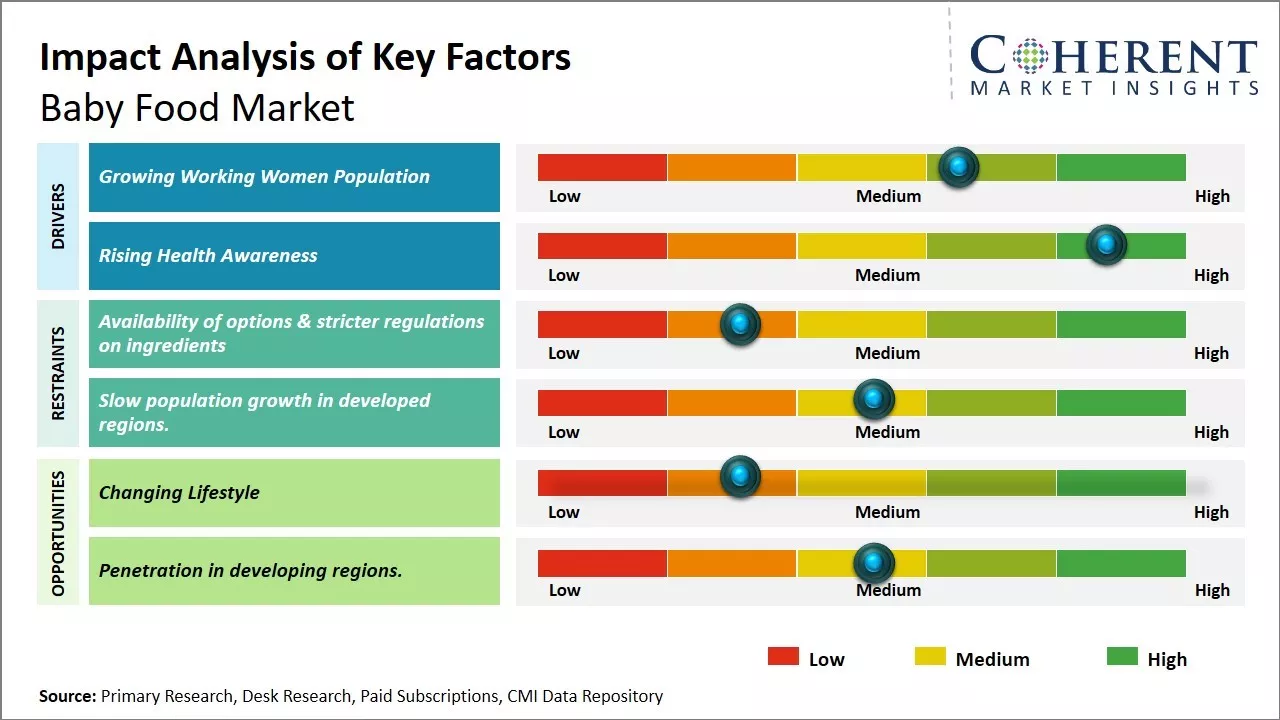
Discover market dynamics shaping the industry: Download Free Sample
Consumers are increasingly looking for organic, non-GMO and clean label baby food products. There is a growing demand for baby foods with added nutrients and DHA/ARA to support cognitive development. Manufacturers are launching baby food pouches and snacks made from fruits and vegetables to cater to the changing demands of busy parents. With rising health awareness, many parents opt for homemade baby food but the market offers convenience through RTE and frozen food categories. The market remains lucrative with innovations in product offerings and packaging formats.
Growing Working Women Population
With more women joining the workforce in modern times, demand for convenience food products for babies and infants has increased tremendously. Working mothers today have very busy schedules trying to maintain a work-life balance and need food options that can be easily prepared or are ready-to-feed. Unlike previous generations where mothers had more flexibility to prepare homemade meals, these time-strapped parents find it difficult to spend hours every day cooking separate meals for their young children. This has opened up a huge opportunity for baby food manufacturers who offer a variety of pre-packaged purees, cereals and other on-the-go snacks. Mothers can simply store these products in their bags or office refrigerators and feed their babies whenever required without any preparation. Working women have acknowledged the benefits of such packaged baby food which saves them considerable time during their tight schedules. Companies have responded with an expanding range of single-serve pouches, bottles and cups containing different flavors and ingredients. Some products have added features like stage-specific nutrition and organic certification to further appeal to time-conscious parents, therefore growing working women population is expected drive the market growth. For instance, according to the data by PIB Gov., in 2023, the female labor force participation rate in the country has improved significantly by 4.2% to 37.0% in 2023.
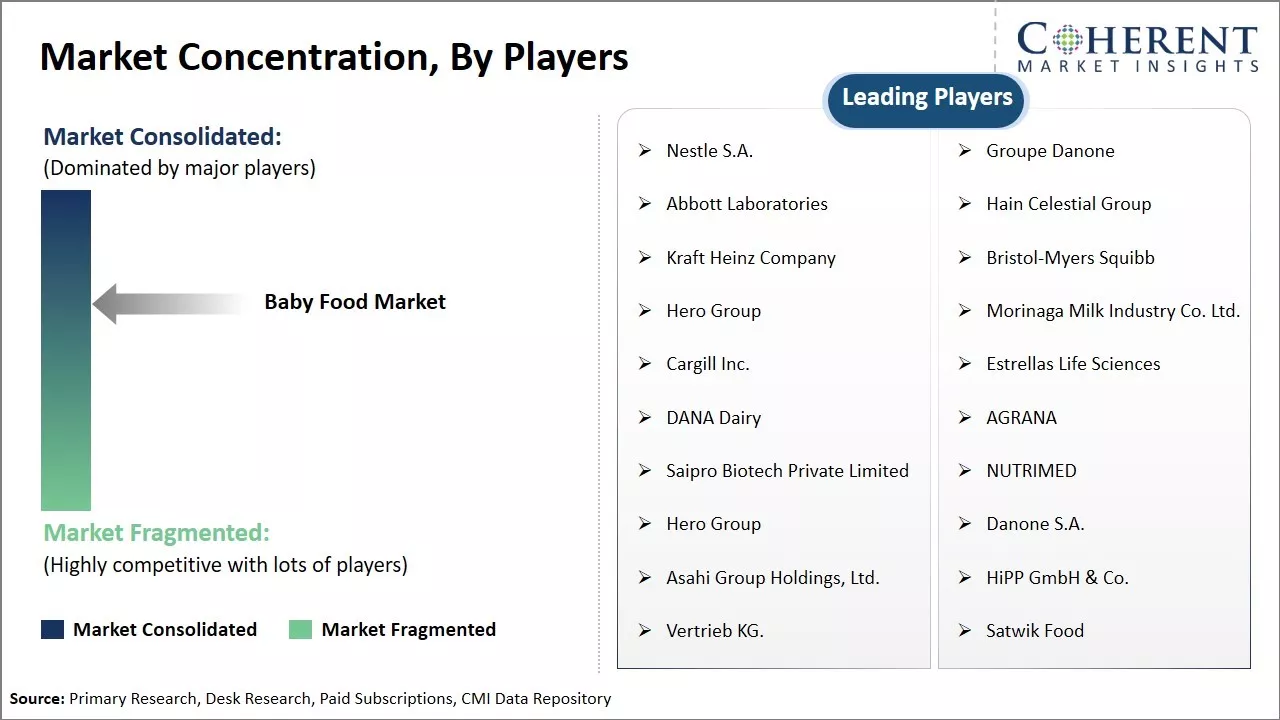
Get actionable strategies to beat competition: Download Free Sample
Rising Health AwarenessParents today are more conscious about their children's diet and nutrition from a very young age. With easy access to health information online, parents want to ensure their babies get the best start by consuming food that supports development and long-term wellness. This awareness has been a driver for premium baby food products tailored towards specific needs. Many parents prefer organic ingredients certified free of chemicals, GMOs and additives, and are willing to pay extra for products marketed as natural, organic or sourced from sustainable farms for the perceived health benefits. There are parents of babies with allergies, colic issues or other sensitivities looking for hypoallergenic or single-grain varieties tailored for sensitive stomachs. Manufacturers have actively responded with free-from ranges.
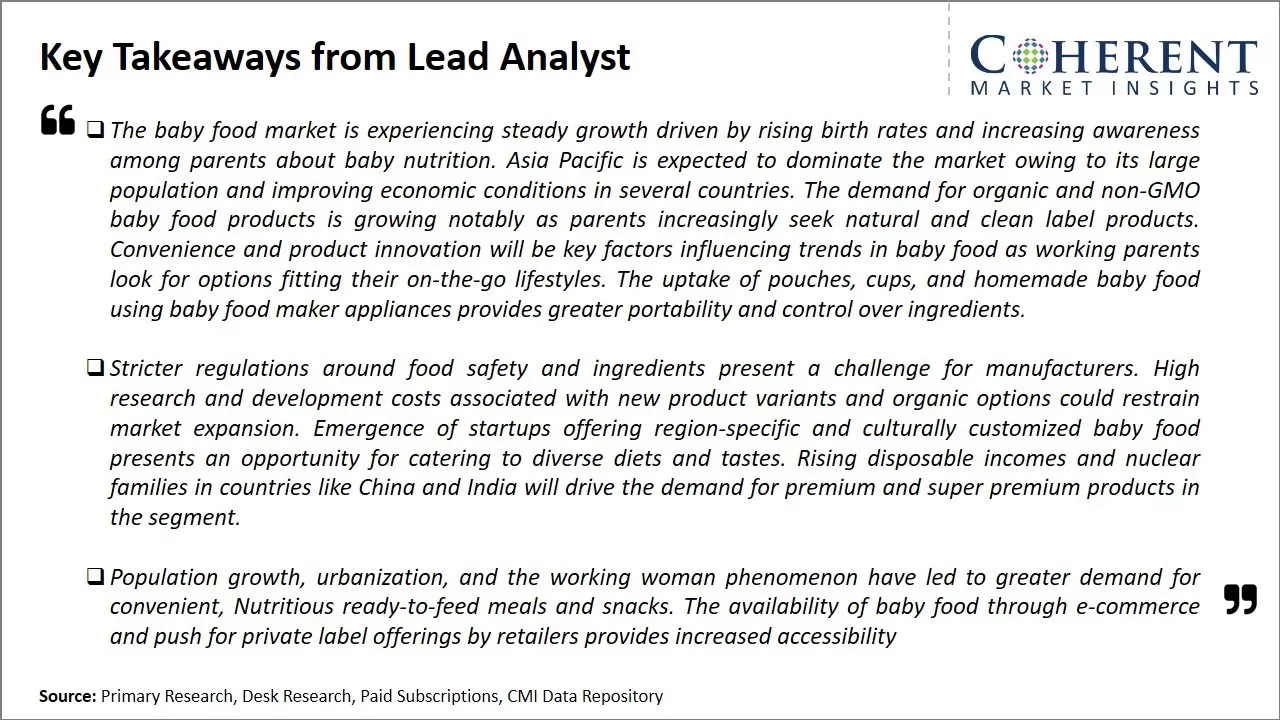
To learn more about this report, Download Free Sample
Market Challenges: Availability of options & stricter regulations on ingredientsGlobal baby food market faces several challenges. Parents have many options for feeding their babies beyond just jarred purees like fresh homemade foods. Eating habits and tastes are also changing as families experiment with baby-led weaning versus purees. Stricter regulations on ingredients present in formulation challenges to ensure nutritional needs are still met. Sustainability is a growing concern, requiring more eco-friendly packaging solutions. Brand loyalty is low and competition is fierce from brands offering organic, non-GMO or regionally sourced options.
Market Opportunities: Changing Lifestyle
As lifestyles get busier, on-the-go ready-to-feed purees and pouches witness increased demand. Exposure to different flavors from an early age means interest in global or fusion inspired flavors.
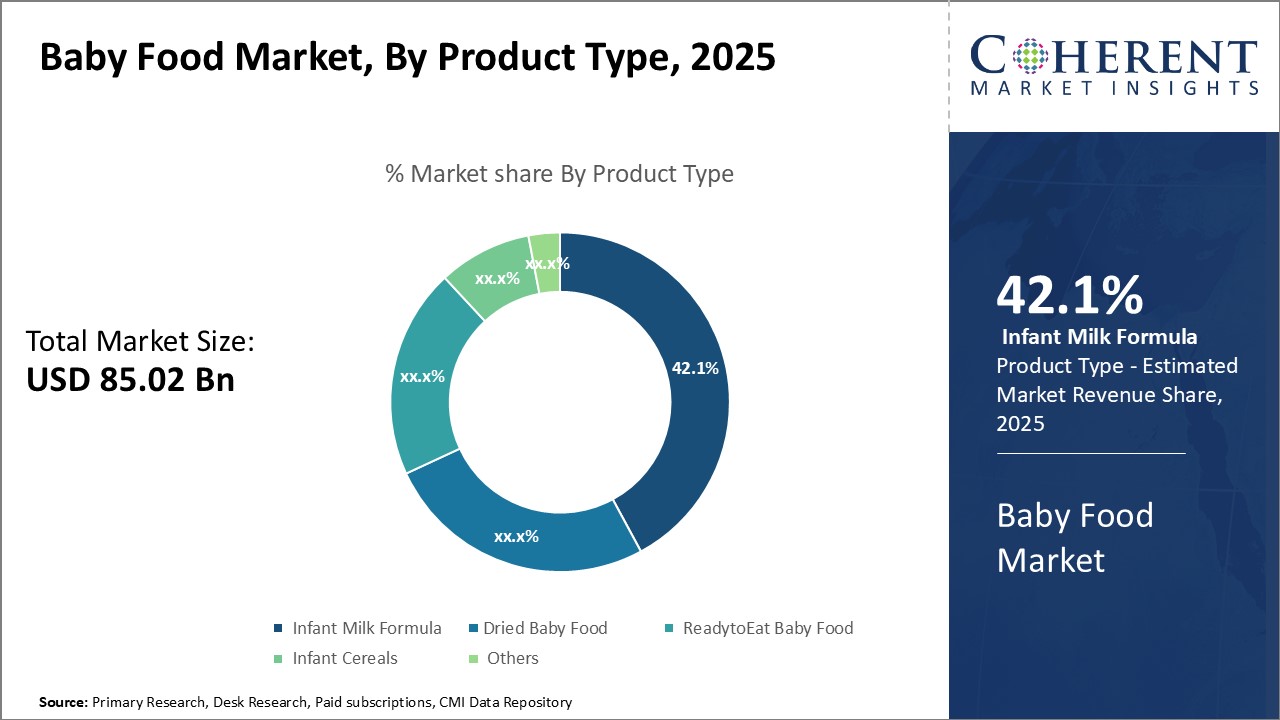
Discover high revenue pocket segments and roadmap to it: Download Free Sample
Insights, By Product Type: Convenience fuels Infant Milk Formula demandIn terms of product type, infant milk formula segment is estimated to contribute the 42.1% share of the market in 2025 owing to its unparalleled convenience. The ready-to-feed liquid formula requires no preparation, making it extremely easy for busy parents to feed their babies anytime, anywhere. Parents struggling to juggle work and family responsibilities appreciate how infant milk formula allows them to avoid the hassle of mixing powders and lets them focus on nurturing their infants. Its pre-made nature simplifies feeding routines and ensures hassle-free nourishment for babies. Busy lifestyles has increased demand for highly convenient options, driving more families to rely on infant milk formula for its unmatched ease of use compared to other baby food product types.
Insights, By Source Type: Health concerns steer demand toward Organic Baby Food
In terms of source type, organic baby food segment is estimated to contribute the 59.1% share of the market owing to rising health concerns among parents. People are increasingly wary of potential contaminants in conventionally produced foods and want to eliminate exposure to harmful substances like pesticides, herbicides, and chemical residues. Opting for organic baby food offers assurance that ingredients have been grown naturally without the use of toxic synthetic fertilizers, irradiation, or sewage sludge. This provides extra peace of mind for parents as babies' developing bodies are highly sensitive. Organically farmed foods are considered more nutritious as these maintain higher mineral and vitamin contents. The emphasis on purity and maximum nutrition has led more parents to choose organic baby food to support healthy growth and development from infancy.
Insights, By Form: Convenience and mess-free eating drives the liquid segment growth
In terms of form, liquid segment is estimated to contribute the 43.9% share of the market owing to the unrivaled convenience and mess-free eating experience it provides. The ready-to-feed format makes liquid baby food incredibly easy for parents as it requires no preparation time. Babies can consume directly from bottles or pouches. The portability of liquid foods also allows parents to feed onthego more readily than with other forms. Liquid baby food is less prone to creating a mess during meals as compared to solid options that may crumble or powdery variants that are easily spilled. This cleanliness factor reduces stress for parents during feeding routines. The fuss-free nature has particularly resonated with time-strapped generations, propelling demand for liquid baby foods as the most trouble-free solution.
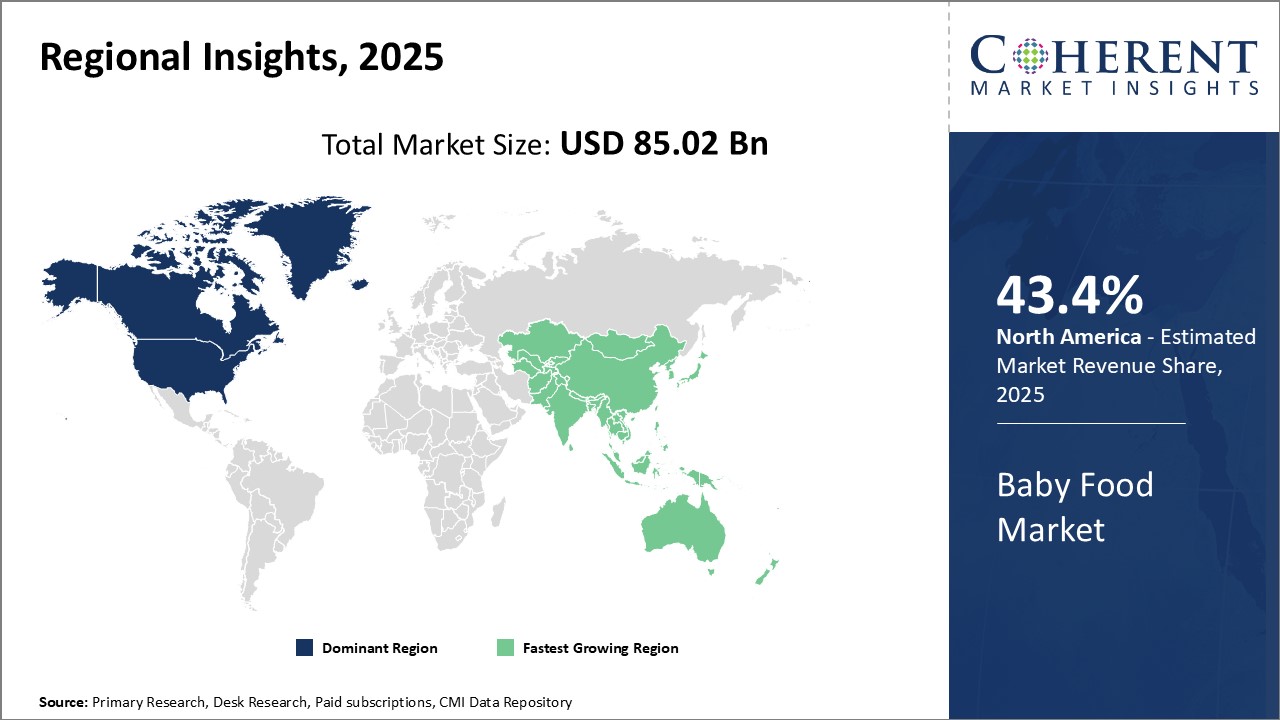
Need a Different Region or Segment? Download Free Sample
North America has long been the dominant market for baby food globally with 43.4%. With countries like the U.S. and Canada having some of the highest birth rates amongst developed nations, the region enjoys a sizable consumer base driving demand. Strong presence of major brands such as Nestle, Abbott and Bellamy's has ensured availability and affordability of products across all sub-categories like infant cereals, milk formula and pureed foods. Rising number of women joining the workforce is expected to drive the market growth. Working parents increasingly rely on convenient packaged baby food options that save time in meal preparation. Exports of North American baby food have also increased steadily, with key Asian markets like China and Indonesia emerging as top importers.
The fastest growing regional market is Asia pacific. Countries within Asia Pacific like Philippines, Vietnam and Indonesia are experiencing rapid economic and infrastructure development alongside growing youth populations. This has translated to rising disposable incomes and more women opting for urban career paths instead of staying home to raise children. Local manufacturers have expanded distribution networks to cater to demand surges in both rural hinterlands and major cities. This has ensured Southeast Asia witnesses heavy patronage of both foreign and local baby food labels alike across various pricing tiers. Together with conducive government policies encouraging larger family sizes, indicators point towards continued momentum for the baby food market in this region going forward.
Baby Food Market Report Coverage
| Report Coverage | Details | ||
|---|---|---|---|
| Base Year: | 2024 | Market Size in 2025: | USD 85.02 Bn |
| Historical Data for: | 2020 To 2024 | Forecast Period: | 2025 To 2032 |
| Forecast Period 2025 to 2032 CAGR: | 6.0% | 2032 Value Projection: | USD 127.92 Bn |
| Geographies covered: |
|
||
| Segments covered: |
|
||
| Companies covered: |
Nestle S.A., Groupe Danone, Abbott Laboratories, Hain Celestial Group, Kraft Heinz Company, Bristol-Myers Squibb, Hero Group, Morinaga Milk Industry Co. Ltd., Cargill Inc., Estrellas Life Sciences, DANA Dairy, AGRANA, Saipro Biotech Private Limited, NUTRIMED, Hero Group, Danone S.A., Asahi Group Holdings, Ltd., HiPP GmbH & Co., Vertrieb KG., Satwik Food |
||
| Growth Drivers: |
|
||
| Restraints & Challenges: |
|
||
Uncover macros and micros vetted on 75+ parameters: Get instant access to report
*Definition: The baby food market consists of a wide range of foods that are specifically prepared for babies starting from six months of age until they are around two years old. This includes baby cereals, packaged baby meals, pureed fruits and vegetables, formula, beverages and other snacks for toddlers. The products contain necessary nutrients in an easily digestible form to support a baby's growth and development. Manufacturers offer different varieties based on stage, taste preferences and organic/conventional options.
Share
Share
About Author
Yash Doshi is a Senior Management Consultant. He has 12+ years of experience in conducting research and handling consulting projects across verticals in APAC, EMEA, and the Americas.
He brings strong acumen in helping chemical companies navigate complex challenges and identify growth opportunities. He has deep expertise across the chemicals value chain, including commodity, specialty and fine chemicals, plastics and polymers, and petrochemicals. Yash is a sought-after speaker at industry conferences and contributes to various publications on topics related commodity, specialty and fine chemicals, plastics and polymers, and petrochemicals.
Missing comfort of reading report in your local language? Find your preferred language :
Transform your Strategy with Exclusive Trending Reports :
Frequently Asked Questions
Joining thousands of companies around the world committed to making the Excellent Business Solutions.
View All Our Clients